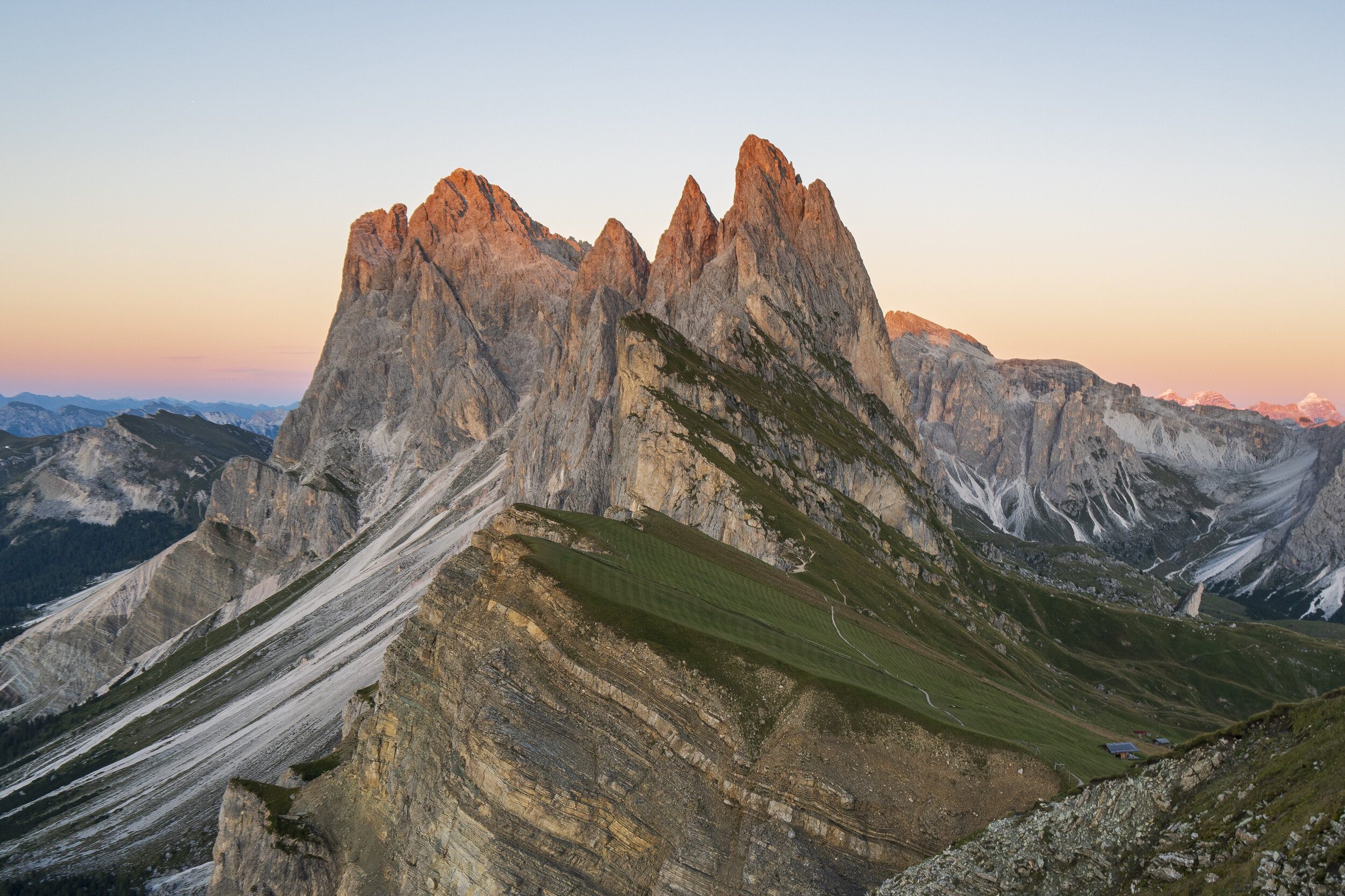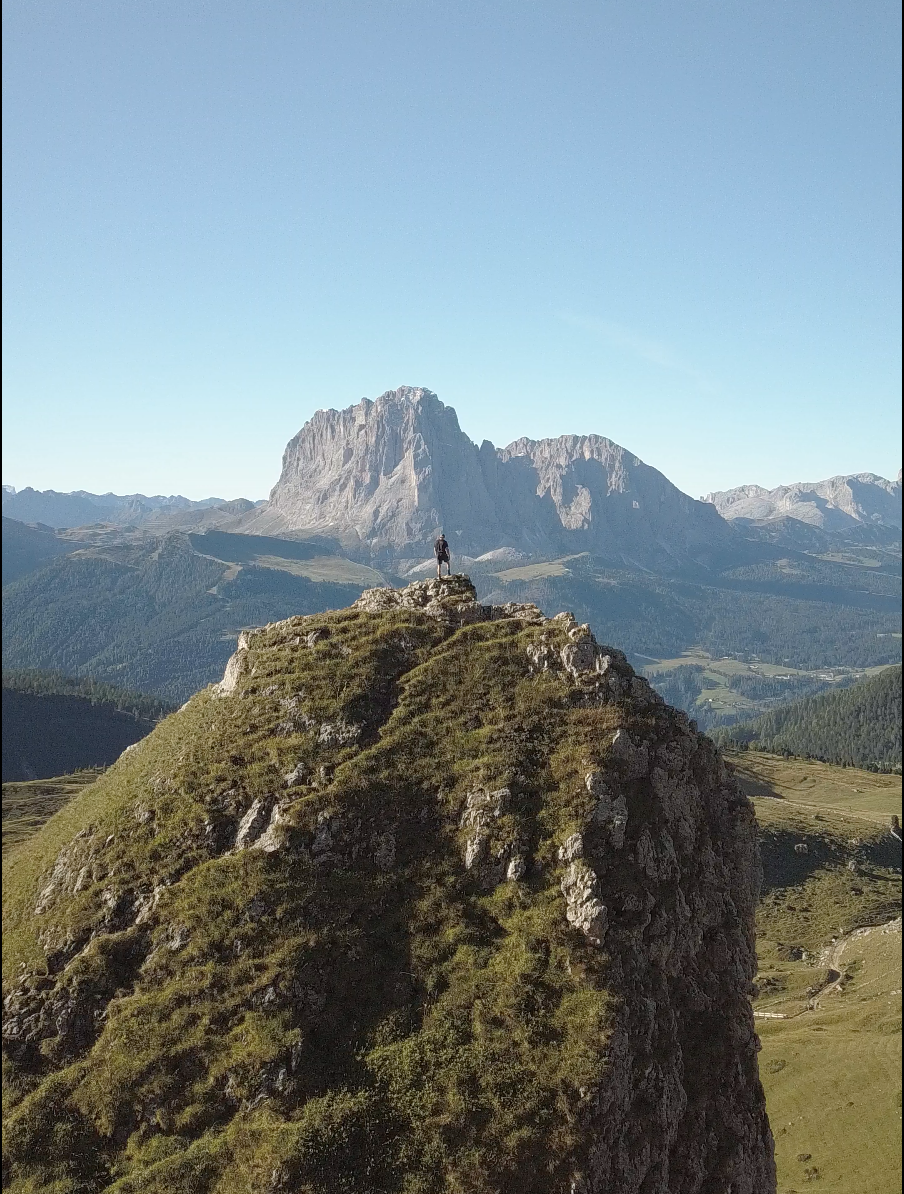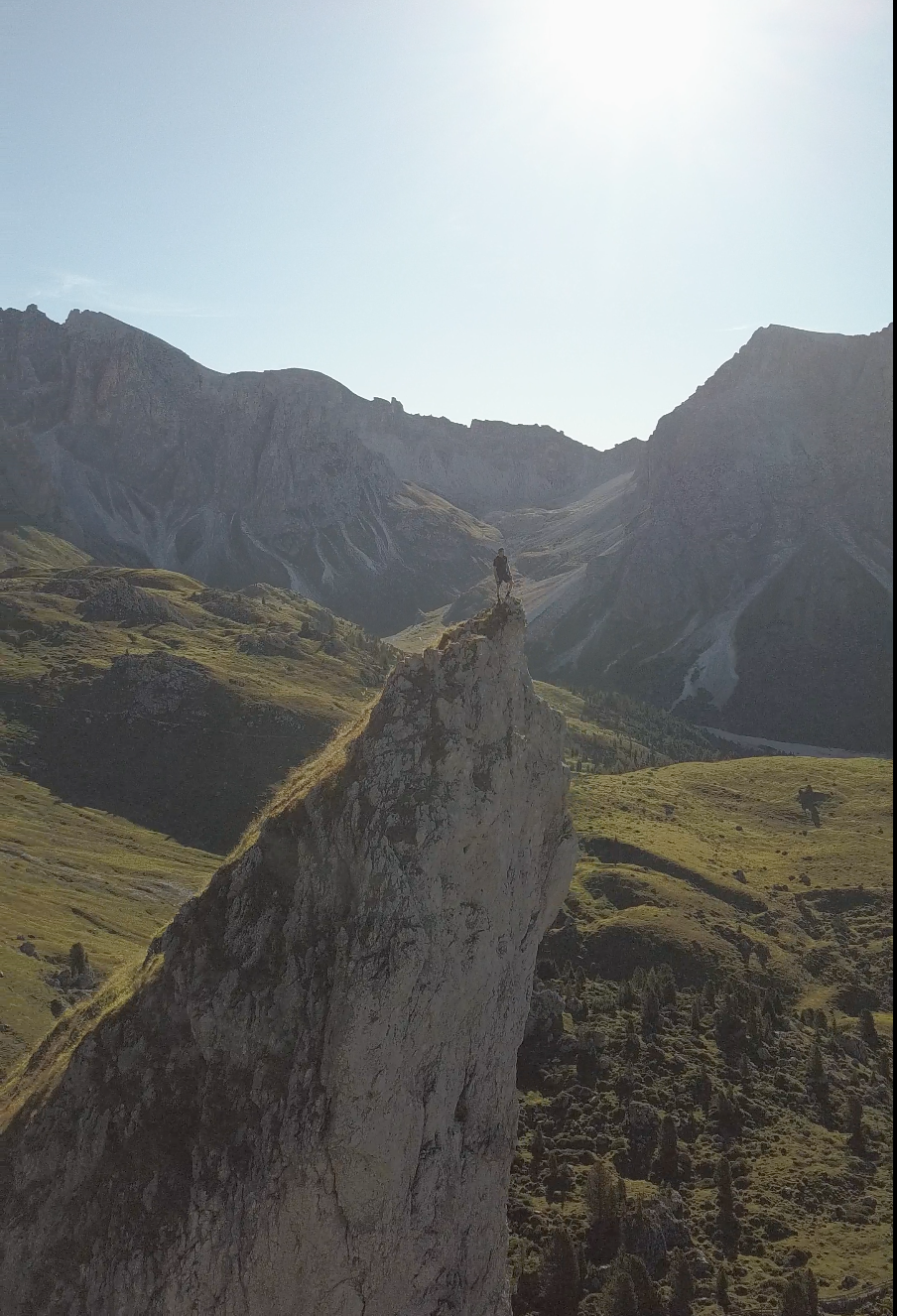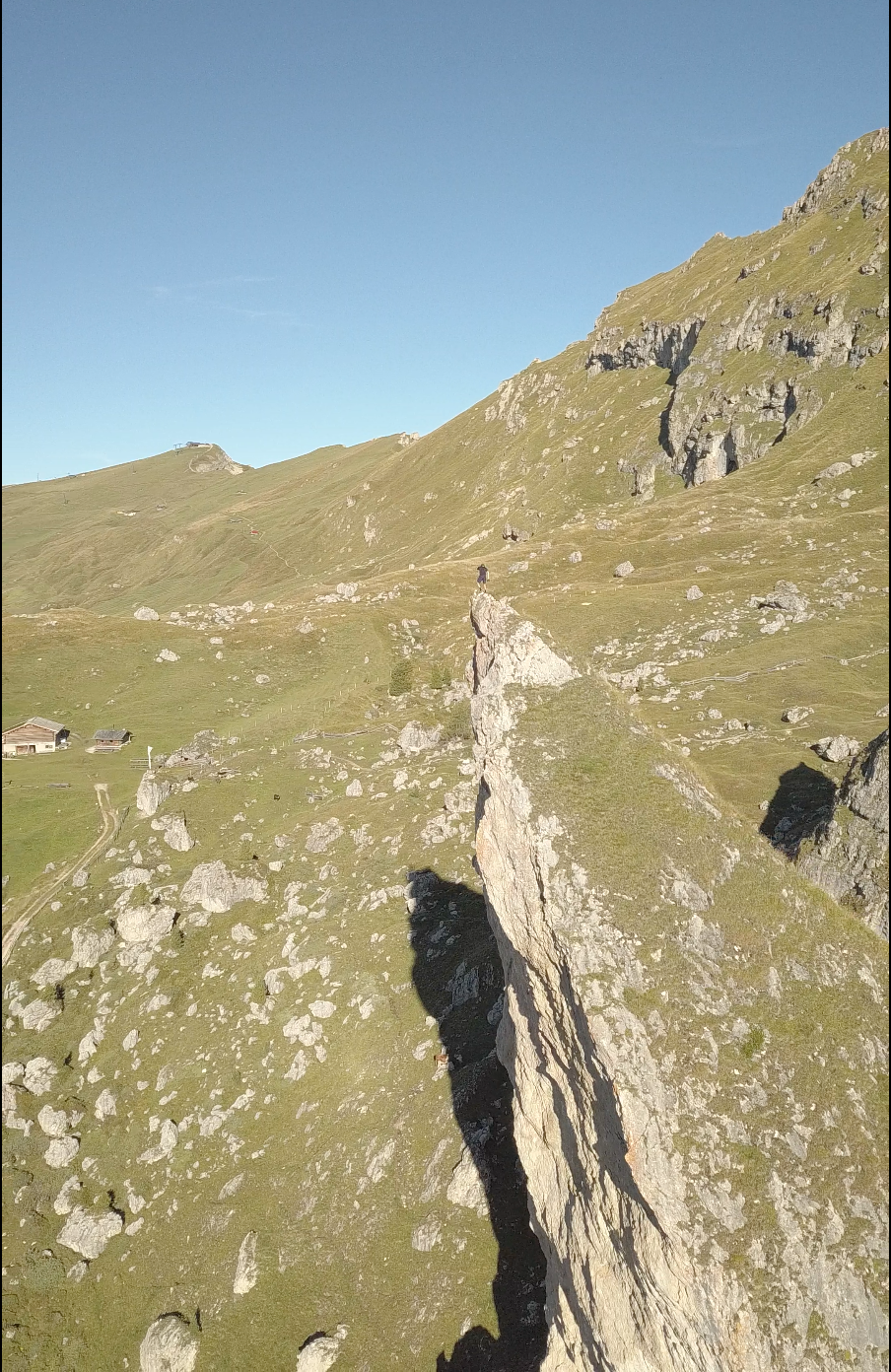Seceda Ridgeline | Hike & Wild camping Guide
Situated in the South Tyrol region of the Dolomites lies the Seceda Ridgeline (Seceda 2,500m), an awe-inspiring, jagged, ridge which protrudes dramatically from the earth surface.
Throw into the mix a luscious green, alpine meadow scattered with the most picturesque, wooden mountain cabins and some mind blowing 360 vistas then you have possibly one of the most dramatic and beautiful locations within the Dolomites.
Within this blog I have outlined the best and most convenient way way to reach the Seceda Ridgeline. The hike is relatively easy going (if you catch the cable car) and is suitable for people of all abilities and ages. I have also included some detailed information about where and how to wild camp up on the ridgeline if that was something that tickled your fancy.
The hike I’ve outlined takes in everything that this dramatic and beautiful area of landscape has to offer and after wild camping up on the ridge and witnessing the sunset and sunrise from such an incredible location, the entire experience was definitely the highlight of my trip to the Dolomites.
So if you are planning on visiting make sure this hike is on your itinerary.
How to reach the Seceda Ridgeline
There are multiple routes to reach the iconic summit, the two I mention below are by far the most convenient and straightforward routes (that still doesn’t mean they are easy) to reach the ridgeline. Both options have car parks at the start of them and both offer a chairlift service which can take you all or part of the way up to the top.
Before visiting the dolomites I would recommend getting the free hiking app ‘Maps.Me’ and downloading the ‘South Tyrol region’.
The offline maps feature highlights all the regions hiking trails, points of interest and amenities. You can also plan hikes through the app; showing you the route, distance, elevation and time it will take complete the hike. I found it extremely useful for gauging how tough and steep the hikes in the Dolomites actually were and made me think twice about attempting several of them, especially with 10-20kg of equipment on my shoulders.
Option 1 - Col Raiser Gondola
This is the route I took and the one I would recommend as you can actually walk along part of the Iconic ridgeline to the viewpoint.
The start point for the hike also makes it much more convenient to explore a little bit more of the plateau, including the Pieralongia, a 200m high, spaceship-shaped chuck of rock which protrudes dramatically from the side of the valley.
The start point for this hike is the Col Raiser Gondola situated in the town of Selva di Val Gardena, on the outskirts of the Village of St Christina. Since the gondola is one of the biggest tourist attractions in the area, there are signs all over the town pointing to the lift station.
There is a large car park above and below the cable car station which is staffed during the day and does cost to park. I unfortunately don’t know how much it costs as when I arrived in the late afternoon (around 4:30 pm) the attendant was gone so I didn’t have to pay. I parked my car here overnight and had no issues returning to it in the morning.
The hike from the car park to the Seceda ridge line is a steep but not too difficult one, it’s 6.4km in length and involves 970m of ascent. The route follows path 1 and 1a up the valley, zig-zagging beneath the gondola and should take 2-3 hours one way.
For those who don’t fancy hiking the entire way, (Don’t worry I was one of those people) you can get the Col Raiser gondola part of the way up.
As there isn’t much to see in the lower part of the valley, I would highly recommend taking the cable car to save time and energy for the upper part of the hike. It’s also a dream on your knees getting it back down in the morning if you were planning on spending the night on the ridge.
The gondola costs €15 one way or €21 for a return ticket. Tickets are valid for one week (perfect for an overnight camp) and can be bought on the day from the gondola station. The lift operates from 8:30am - 17:30 and the jounrey should take around 10 minutes
From the top of gondola station the 3.5km hike to the Seceda viewpoint involves 430m of ascent and should take around 1 hour. There are several well-signposted paths up to the ridge but I would recommend taking route 1 and hiking past the Baita Troier restaurant. From here you will be able to work your way up to the most western part of the ridgeline then hike your way across it to the viewpoint.
An alternative route from Ortisei
If you are a straight-up lunatic and wanted to add a little more difficulty and distance to your hike up to the ridgeline, or were the complete opposite and wanted to get a cable car the entire way up then consider starting from the Village of Ortisei.
The hike from the village of Ortisei to the Seceda viewpoint is 7.5km, involves 1,300m of ascent, and should take between 3-4 hours one way. The route from that hike can be found here.
The cable car option consists of catching two lifts, one from Ortisei to Furnes, then from Furnes to Seceda. The price for both lifts is €25 one way or €34 for a return ticket. Tickets and more information can be found here: https://www.seceda.it/
There is parking in Ortisei near the cable car station but I unsure of the specifics as I didn’t want to spend my trip to the Dolomites visiting car parks like some kind of dogging enthusiast.
First light touching the lushious green slopes of the Seceda ridgeline
Notes on wild camping In Italy
First things first, it’s actually illegal to wild camp in Italy and if caught you can be hit with a significant fine.
So in no way am I promoting or saying you should go and wild camp on the Seceda Ridgeline, despite it possibly one of the most dramatic and awe-inspiring ridges that I have ever had the pleasure of visiting….
Now that is cleared up, as far as I’m aware there is no such thing as the Italian mountain police and given that you practice wild camping safely by having the right equipment, and following the ‘unofficial rules’ (which I have outlined in my blog post below) then you might just have one of the most incredible wild camping experiences of your life, ever.
Where to Wild Camp?
Before I even left the UK, I was anxious about where I would pitch a tent once I was up on the ridgeline.
After arriving with plenty of time and enthusiasm just in case I had to make the sorrowful hike back down in the dark, my fears were quickly eased upon arriving at the summit and discovering that there’s a large, flat patch of grass located at the highest section of the viewpoint.
The wild camp spot which is the highest part of the viewpoint, the building on the right is the top of the Fermeda Ski lift.
The area is ideal for Wild camping and is situated around 100m to the west of the Croce del Seceda statue, directly above the Fermeda chair lift. From here you look directly down the ridgeline in addition to having spectacular 360-degree views of the surrounding mountains. If you wanted to get your bearings you can explore the area via google maps Here.
This spot is a little exposed and might be susceptible to a lashing from the wind so bare this in mind when heading up there. If it is super windy there are several other areas around the Fermeda ski lift that you could easily pitch up at.
Again when wild camping, remember to bring the right equipment, pitch up as late a possible/strike down early and most importantly make sure you leave no trace of you being there.
The camping experience & advice
I would advise getting a return ticket on Col Raiser gondola to save your legs and planning on being up on the ridgeline at least an hour and half before sunset to take in the incredible views.
I attempted this hike and wild camp in late August 2019 and it was my first official day and night in the Dolomites. I got the lift up around 5pm and arrived on the ridge shortly after 6:30pm. The car park and trails were very quiet and after departing the upper gondola station I only saw a handful of people.
Upon reaching the ridge I was met by three other hikers but they stayed on a lower section of the ridgeline, several hundred meters from the main viewpoint where I eventually pitched up.
After around half-hour of reaching the viewpoint, I was greeted by a very flustered and out of breath German man named Simon who was also planning on wild camping at Seceda. Unfortunately for him he chose not to get the gondola up up and spent several hours, lugging all his equipment, in 3 separate bags up from the bottom car park.
His bright red, flustered face and breathing which sounded like an asthmatic in a saw-mill quickly reassured me that I had made the correct decision to get the chair lift part of the way up.
Despite Simon being a complete stranger, It put my mind at ease knowing that another person was also wild camping up there. It was also comforting knowing that if we were caught by an angry Italian, that I wouldn’t feel the full brunt of their displeasure.
The sunset was absolutely incredible and one of the best I have witnessed. Myself and Simon had the place to ourselves and didn’t see another person the whole time we were up there.
When attempting to find a toilet whilst on the summit I discovered that that the lower section of Ristorante Seceda was actually left open all evening.
Beneath the restaurant and in front of the cable car boarding area there is a small, heated indoor room which had a picnic table, benches, lights alongside a well-maintained toilet facilities. I’m not sure if this facility was accidentally left open or is available year-round, but it was a perfect spot to relax and eat a meal after sunset.
As it was delightfully warm, cosy and sheltered from the elements it could easily serve as a rescue shelter for at least half a dozen people if the weather does take a turn for the worse.
After an undisturbed but rather chilly night in the tent regretting not sleeping beneath the restaurant (the ridgeline sits at 2,500m so bear this in mind when choosing a sleeping bag) we woke to an even more incredible sunrise.
There were already two photographers set up by the top of the ski-lift looking down the ridgeline and shortly after sunrise we were joined by several other hikers.
Sunrise from the seceda viewpoint. If you look to the middle right of the image you can see the Pieralongia, blue whale shaped rock protruding from the plateau.
After packing down the tents around an hour or so after sunrise, we then both hiked back along the ridgeline before venturing down and across to the Pieralongia. The walk back across the empty meadow beneath first light was an incredible experience and made the wild camp even more magical.
The Pieralongia is a set of rugged rocks which protrude dramatically from the earth surface. To me they resembled the crash site of an alien spaceship, but have been described as bunny ears and pride rock from the Lion King. Whatever they look like they are fascinating pieces of topography set amongst some of the most dramatic landscape in the Dolomites.
You are able to clamber up on top of this rock as i did int he photos below, but be warned it is rather tricky and not for the faint-hearted.
Roaming feely beneath the rocks are a small herd of friendly donkeys, which I believe belonged to Rifugio Pieralongia, a tiny weathered mountain hut next to its namesake which that offered simple meals, drinks and snacks.
From the Pieralongia we then made the long descent back to the car park, well Simon did, I thankfully bought a return ticket saving the knees form over an hour of savage descent.
I hope you found this blog useful and if you have any questions or want to add anything to this guide then drop a message in the comments below.










